TOWING THE LINE THE REGULATIONS SUMMARISED
The ability to target different species around New Zealand is a big part of owning a trailer boat and an important part of the kiwi fishing culture. Depending on the size and weight of the craft, along with towing vehicle and trailer specifications, a variety of rules apply. Dan Govier explains the finer points.
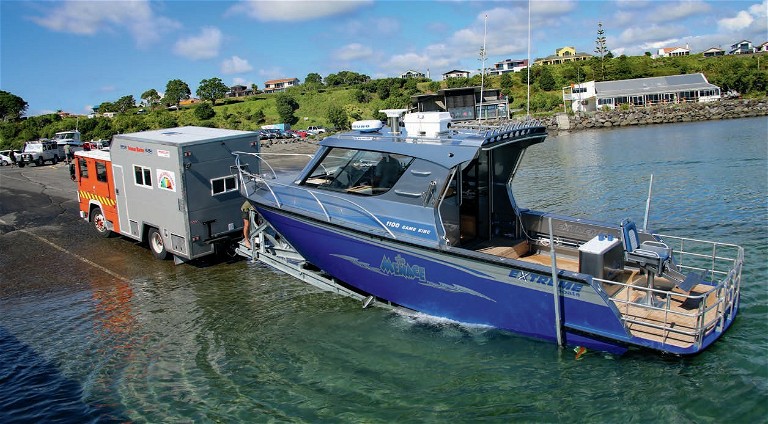
Horses for courses – this Extreme 1100 can quite safely be towed on the road by this former fire truck under COF requirements.
When we head out fishing, the final thing most fishers do is hook the boat on and tow it down to the boat ramp. However, this is not always as simple as it seems. Many people towing boats do not know (or ignore) the legal requirements and don’t realise the implications this could have should an incident occur. If you don’t have your vehicle, trailer and brakes within the set specifications and regulations, you may have no insurance should an accident occur, regardless of whether you are at fault or not.
I have recently been through a new build process where the boat was heavier than 3,500kg, which is too heavy for a Warrant of Fitness (WOF) trailer. As a result, a trailer in Certificate of Fitness (COF) was required.
To be sure the rig was compliant, I did a significant amount of research, which wasn’t an easy process. As a result, I have summarised below the rules, regulations, and requirements around towing a boat and trailer in various weight classifications.
The average size of trailer boats has increased over recent years, enabling fishers to travel further afield and have overnighting ability. However, as these boats increase in size, more equipment is being placed in and on them, further adding to their tow weight. Large fuel tanks are now commonly fitted to bigger trailer boats, and it is not unusual to see a trailer boat with 4-500 litres of fuel on board.
Hopefully, this information will provide an insight into what you need to ensure your boat trailer is compliant when towed on the road.
Light Trailers
There are two classifications of trailers in NZ. Light trailers (including their laden weights) must weigh less than 3,500kg, whereas heavy trailers are those trailers heavier than 3,500kg. The weight of a boat and trailer is the total weight on the jockey wheel; it cannot be weighed whilst hitched to the tow vehicle as this transfers some weight to the tow vehicle.
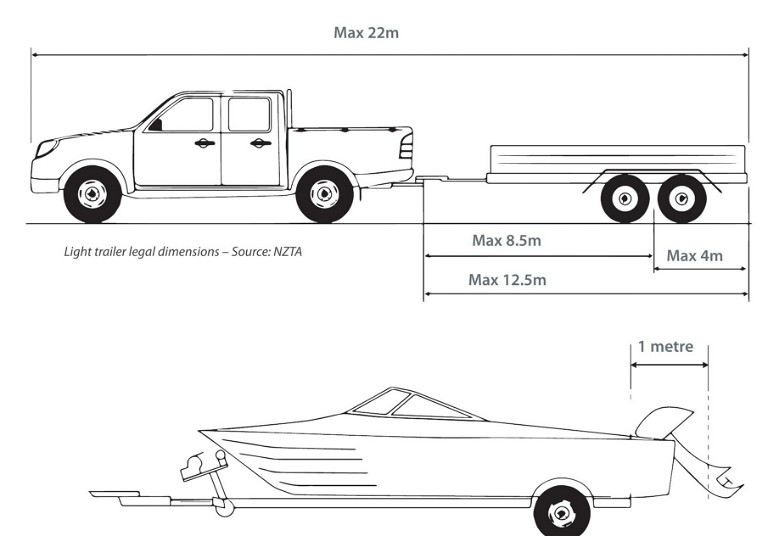
A warning device is required if the outboard extends one metre of more beyond the back of the trailer
Most vehicles have a certification label/plate on the towbar detailing the maximum towed mass (braked and unbraked) and the maximum vertical load the vehicle can safely tow. Most 4X4s have a tow rating of 750kg unbraked, 3,500kg braked, and a downforce of 350kg. The law does not enforce these ratings, but it is recommended, and the question will be, if an incident did occur, would your insurance company cover you? From discussions with insurance companies and reviewing policies, if it is determined that your vehicle and trailer are not compliant with all of the regulations or specifications of the vehicle to be towing on the road, there will be no cover.
However, the law requires that a light vehicle and trailer combination stop within a distance of 7m while travelling at a speed of 30 km/hr. This means the maximum weight your vehicle can tow on an unbraked trailer is restricted by the braking ability of the vehicle that is used for towing.
Heavy Trailers
A heavy trailer classification applies when the laden weight exceeds 3,500kg but less than 10,000kg.
The maximum mass of the trailer cannot be more than 50% higher than the mass of the vehicle which tows it. This ensures the trailer can be controlled during braking and emergency manoeuvres. A heavy trailer requires COF and these requirements are summarised further below.
Trailer Brakes
There are three different types of brakes used on trailers, and the requirements are dictated by the gross laden weight of your trailer. These include:
Service brakes can be either direct or indirect. Direct brakes allow the driver of the towing vehicle to regulate the trailer brake effort from the driving position. Indirect brakes are activated when the tow vehicle brakes and causes the trailer to push against the tow vehicle and indirectly controls the trailer brakes, often known as override brakes. Service brakes must act on both wheels on at least one axle and are also required to stop the trailer and tow vehicle within 7m from a speed of 30 km/hr.
Breakaway brakes are generally electric over hydraulic and activate on the trailer when the brakes are applied in the vehicle. The difference with these brakes is if the trailer is accidentally disconnected from the vehicle, they will be activated automatically.
Parking brakes are applied by hand when the trailer is disconnected from the tow vehicle. To comply with the standards, they must be capable of holding the trailer at rest on a slope of one in five.
There are three weight classifications for light trailers within WOF specifications and this dictates the type of brakes, whether a parking brake is required, and whether safety chains are required. This is summarised below.
Trailers with gross laden weight <2,000 kg
• No Brakes required if the rig can meet stopping standards of 7m at 30 km/hr
• Parking brake not required
• Breakaway brakes not required
• Safety chains are required – must be of sufficient strength to hold the trailer securely.
Trailers with gross laden weight between 2,000 - 2,500kg
• Service brakes are required – either direct or indirect
• Parking brake is not required
• Breakaway brakes are not required
• Safety chains are required. Coupling must also have a manufacturer rating compliant with the weight being towed and twin safety chains must cross each other when connected.
Trailers with a gross laden weight 2,500 - 3,500kg
• Service brakes are required – must be direct
• Parking brake is required
• Breakaway brake is required
• Safety chains not required.
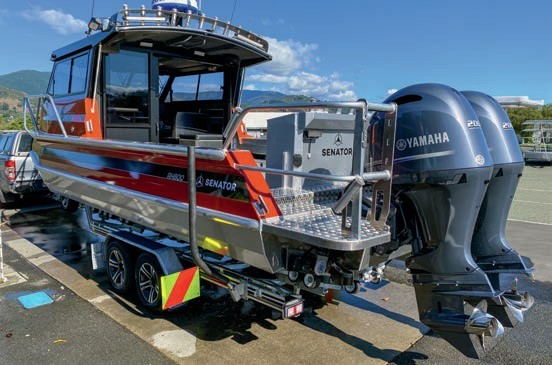
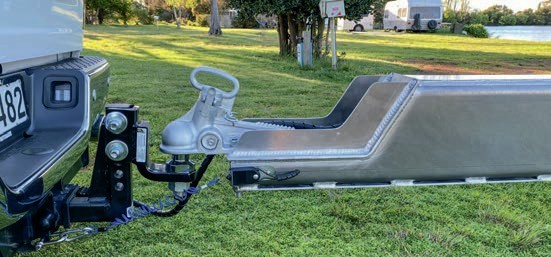
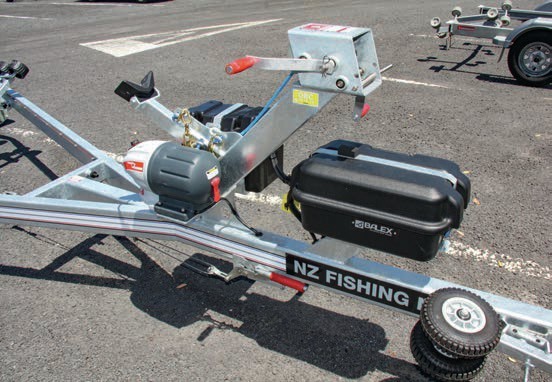
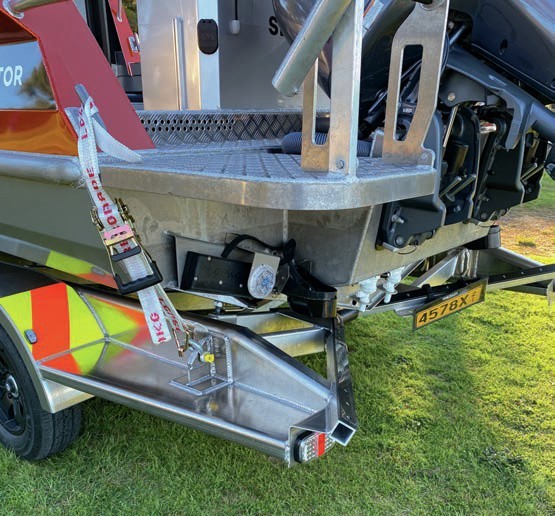
Light Trailer Requirements
The maximum width of a light trailer is 2.55m and excludes lights, indicators, and the bulge at the bottom of the tyre. The maximum length, including drawbar and boat, is 12.5m, while maximum height is 4.3m. The maximum rear overhang allowed on a light trailer, which is the distance between the rear axis (i.e. between two axles) to the rear of the load, is set at 4m. When the outboard is raised for travelling, and it extends beyond 1m from the most rearward point of the trailer, one warning device must be attached to the centre of the projecting load (i.e. propellor). These warning devices include:
• A flag/prop flag during daylight hours
• During the hours of darkness, it must have a red light visible from at least 200m away. Flags may also be displayed at the same time.
• Overwidth Trailer Restrictions
• Boats wider than 2.55m are classified as oversize or overdimension loads. Any boat wider than 2.55m and less than 3.1m wide on the trailer, is classified as a Category 1 over-dimension vehicle. To tow an over-dimension trailer on the road you don’t need a permit, you simply need to adhere to the requirements of Factsheet 53a on the Waka Kotahi website, as well as complying with the light trailer requirements above. The requirements for compliance with Category 1 are listed below:
• Must display fluorescent yellow flags (during the day only) or hazard panels made from retro-reflective material with a diagonal orange stripe.
These must be at least 400mm long and 300mm wide.
• In any city area, an overdimension vehicle/trailer must not travel: Between 7am-9am or 4pm-6pm, Monday to Friday Between 10am-1pm or 4pm-7pm on Saturday or Sunday. Or at any times of unusually high traffic volumes.
Driver Licence Requirements
Most drivers have a Class 1 – car licence. This allows you to drive a vehicle and trailer with a combined mass of up to 6,000kg. This weight limit takes into account all of the contents of the tow vehicle, including passengers and gear. When your combined vehicle and boat/trailer weigh more than 6,000kg, you are required to have a Class 2 licence. A Class 2 licence allows you to tow a trailer with a combined weight up to 18,000kg if required.
Certificate of Fitness (COF)
When your combined boat and trailer weigh more than 3,500kg you are legally required to have a COF as opposed to a WOF. It is illegal to tow a boat and trailer with a combined weight of more than 3,500kg, including fuel, fishing gear and any ice/fish etc without a COF. These days, boats above 7.7m are going to be very close to 3,500kg when fully loaded. The implication for not having a COF is that you are not legally allowed on the road. If weighed, your boat could be pulled off the road, requiring a low loader to get home. If you have an incident, whether it is your fault or not, you will have no insurance cover. This also means if you were rear-ended by another vehicle, and they were at fault, their insurance would not cover you as you are not considered to be legally allowed on the road.
1) Dan’s Predator RH800 weighs over 3500kgs, so comes under Certificate of Fitness towing requirements.
2) Couplings and tow hitches must meet COF requirements.
3) Trailers and boats with a combined weight of 2500 to 3500 kilograms come under WOF rules, but still need a direct service, parking and breakaway brake, but not a safety chain.
4) The boat must have four points of contact – winch, safety chain and rear straps or strop. Note the hazard panel, another COF requirement.
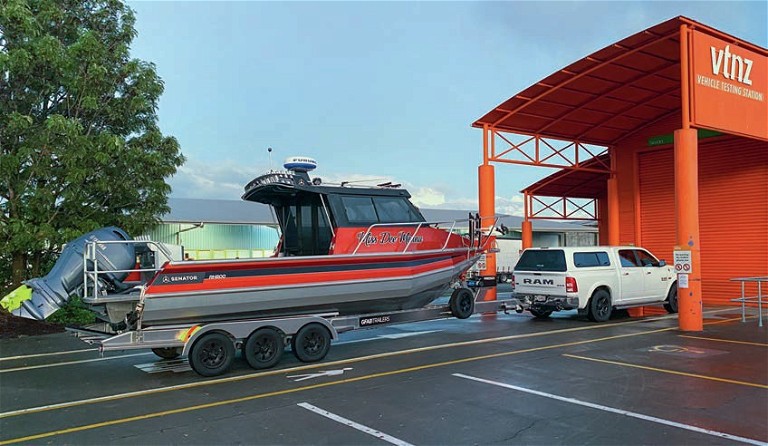
A COF Inspection is required every six months.
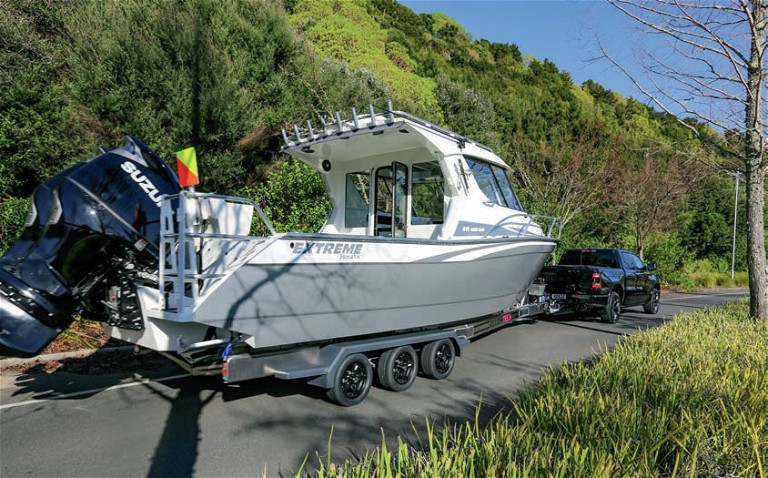
If your boat/trailer/vehicle rig exceeds 6000kg, you will need a Class II license to operate on the road.
To comply with COF requirements is very onerous and I do not have enough room here to tell you of the process I went through to achieve compliance. A trailer in COF requires a certificate of loading which states the various required weight ratings, the brakes to be certified, built to an engineered design by a certified welder, load anchors and towing connection needs to be certified, a hubometer fitted and road user charges apply. The trailer must be tested very six months for compliance.
I contacted just about every trailer manufacturer in NZ when I was looking at COF trailers, and most did not want to even touch them; however, GFAB trailers were very accommodating and built me an amazing COF trailer. GFAB have invested in their business to build COF trailers, and these are works of art. If you need to go into COF, I would certainly recommend them.
Trailer Maintenance
Trailers are the point of contact between your boat and the road, so regular maintenance is essential. This might include regular checks to ensure there are no cracks or faults and that the wheel nuts are tight. Wheel bearings and brakes are constantly exposed to saltwater and rust never sleeps, so washing your trailer down well is a must. Always ensure your tyres have tread and have the correct pressure. Many trailers don’t have a spare wheel, but this is a cheap investment should a tyre go flat.
You should have four points of contact to secure your boat safely on the trailer. This includes the winch rope, safety chain, and two tie downs at the back of the boat to the trailer.
Hopefully, this article has provided you with a better understanding of the legal implications and obligations when towing your boat on the road. The level of requirements and restrictions are dictated by the weight and size of your boat. Given the implications of non-compliance, it is highly recommended that you consider all rules and regulations for your current or the next boat you purchase.
Key points are:
• Don’t exceed the capacity of your tow vehicle. This is not a legal requirement, but if you exceed the towing capacity, you must ensure you can stop safely.
• Check whether your insurance policy defines overloading – irrespective of law, exceeding a tow vehicle’s capacity may be an exclusion on the policy.
• Don’t exceed your vehicle’s gross vehicle mass (including passengers and gear).
• Don’t exceed your tow vehicle’s gross combination mass (tow vehicle and attached trailer)
• If the trailer and boat is >3,500kg, it should be in COF.
• The gross mass of a COF trailer cannot exceed 1.5 times the gross mass of towing vehicle.
• A Class 1 licence can only tow up to 6,000kg gross combined weight of vehicle and boat, otherwise, Class 2 is required.